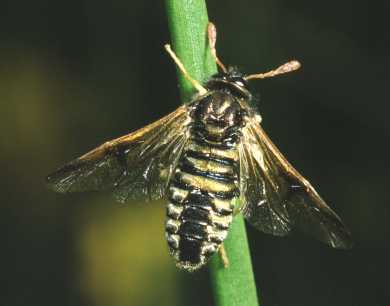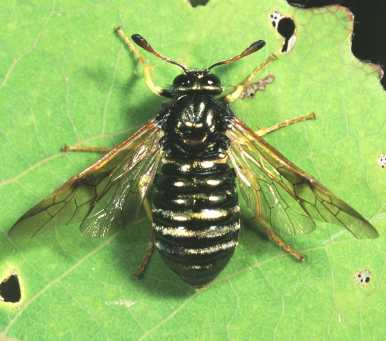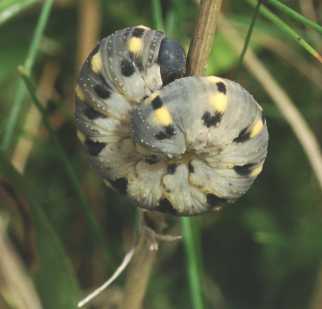| I have previously documented
records (Worcestershire Record. Number 7, November
1999) for two species of Abia sawfly at Mill
Meadow, Drakes Broughton, SO919483. The genus Abia
belongs to the family Cimbicidae, comprising
fourteen species in the British Isles. All cimbicids are
large robust insects recognisable by their five segmented
antennae ending in distinctive 'clubs'. All are believed
to be declining and are either very localised or rare.
Previous records for Mill Meadow were thought to be of
both Abia sericea (Linnaeus) and Abia candens
(Konow). I now believe that all previous records for Abia
candens are incorrect and that only Abia sericea
is present at the site. I first captured a specimen of an unusual looking cimbicid sawfly on flowers of Angelica at Mill Meadow on 29.7.1999, which I passed to John Meiklejohn, and which was then killed for further taxonomic study. We both carefully followed the keys as set out in Quinlan & Gauld. 1981, Handbook for the Identification of British Insects, 6,2(a). Symphyta (except Tenthredinidae). New Edition. According to these keys we had captured a male Abia candens, one of the specific features being the peculiar deep depressions on the upper surfaces of segments 4-7 of the abdomen. The text mentions that the male Abia candens is 'excessively rare in Britain'. I have since found and photographed several more males of 'Abia candens', almost with embarrassing ease! It has concerned me that I should keep on finding these 'excessively rare' sawflies regularly. Meanwhile, I have been finding another cimbicid sawfly at the site with less regularity. A slightly larger insect, obviously an Abia, and without the deep groove-like depressions on the upper surfaces of segments 4-7 of the abdomen; these have all keyed out as female Abia sericea. I have recently acquired an earlier set of keys for the identification of sawflies. This is basically the previous version of the handbook mentioned above, but the author is R.B.Benson, 1951. Crucially, there is a line drawing on the page next to the Abia keys depicting abdominal depressions on the male Abia sericea, to which no reference is made in the 1981 handbook. This, I now know, led me to record male A.candens which were in reality male A.sericea. A reliable distinction between the males of the two species requires microscopic examination of the front of the head. In male A.sericea the space between the top of the eyes (the interocular space) is as far apart as the diameter of an ocellus. In male A.candens the interocular space is as far apart as half the diameter of an ocellus. This is immediately apparent when viewed under a microscope, as it was to John Meiklejohn and myself when we recently re-determined our specimen from 29.7.1999 to be a male of Abia sericea. Furthermore, the male of A.sericea is commoner than the female, which ties in well with data from Mill Meadow. The larval food plant of Abia sericea is Succisa pratensis (Devil's-bit Scabious), which is abundant at Mill Meadow, and I have photographed the larva there twice, on 10.9.2000 and on 1.10.2000. In summary, all previous records of Abia candens at Mill Meadow should now be treated as being Abia sericea. I thank John Meiklejohn and Paul Whitehead for assisting with this note. |
Abia sericea (male)
Abia sericea (female).
Abia sericea (larva).
|


